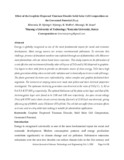Effect of the Graphite Dispersed Titanium Dioxide Solid Solar Cell Composition on the Generated Potential (VOC)

View/
Date
2020-09Author
Kimemia, David N.
Njoroge, K. W.
Mwangi, W. I.
Metadata
Show full item recordAbstract
Energy is globally recognized as one of the most fundamental inputs for social and economic development. Most energy sources are serious environmental pollutants. To overcome this challenge, presence of abundant sunshine was exploited through use of photovoltaic cells. However most photovoltaic cells are silicon based hence expensive. This study reports on the fabrication of a cost effective and environment friendly solar cell by use of TiO2 and I2/ KI (dispersed in graphite-Cx) layers in their solid form to provide an alternative source of clean energy. TiO2 has a high photo generation ability when excited with radiation and is chemically inert over a wide pH range. The photo generated electrons were replenished by iodine complex and graphite facilitated their migration. The mixtures at varying ratios were made into pellets and their electrical properties investigated. The optimum electricity generation was observed at the ratio of TiO2/ Cx: I2: KI as 0.4: 0.3: 0.17: 0.01 g respectively. The optimal thicknesses of the photo active layer and that of the electronegative layer were found to be 2.00 and 1.00 mm respectively. An open circuit voltage (Voc) of 0.979V and a short circuit current density (Jsc/cm2) of 12.037μA was observed, giving efficiency (η) of 0.006% and a Fill factor (FF) of 0.64. The cell did not suffer from corrosion effects as it was used in a dry solid state making it suitable for photovoltaic application.
URI
http://journal.kyu.ac.ke/index.php/library1/article/view/74http://hdl.handle.net/123456789/4640
